Softcore doesn’t sound like what any red-blooded adventurer would want to be called. Especially not us burly, surly Aussie adventure-bike blokes ’n’ birds, which is probably why Triumph sell more of the off-road favouring XC Tiger 800 than the XR, and KTM sell more 1190Rs than standard 1190 Adventures. But who needs what, and why?
Sometimes the decision between the gnarly-road and soft-road models seems to be settled by a big fat case of the ‘just in case’. Just in case I have a spare weekend and think, ‘F**k it, Dakar is on, might as well get the bike out and have a go! Ah bugger, I didn’t buy the one with a 21-inch hoop on the front, I’ll have to stay home and jetwash the dog instead.’
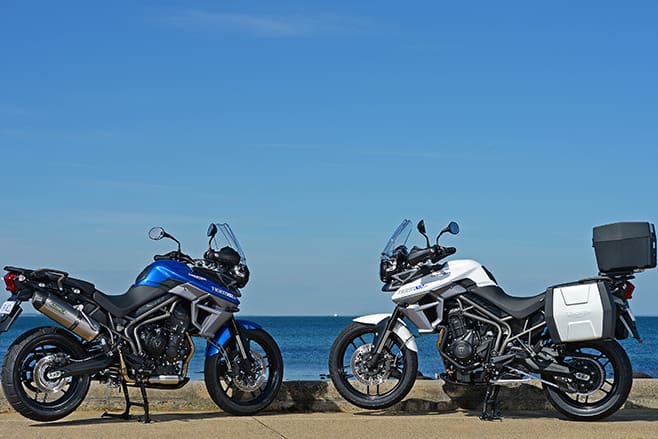
Well, it’s probably a good call to forget your Dakar debut, but the 19-inch dualsport tyred wheel on the front of your softroader shouldn’t stop you from getting out in the boonies for a dirty time. It’s probably a lot more capable than you think. And in the case of the XRx, it could even be more capable than you are.
My first thought riding the XRx away from Triumph Australia’s new Melbourne HQ was how much things have changed since the days when an 800 was considered to be in the big-bike category. Hell, a 750 was a superbike not that long ago. Nowadays, this 800cc Tiger is a slim and nimble lightweight tourer.

Never mind why would anyone want the soft-road model Tiger, why the hell would anyone want a bigger and heavier bike than this? Sure, the torque of a 1000 to 1200cc bike is nice, but they are also usually a big old lump to manoeuvre around town, and cruising speeds beyond the city’s limits is governed by the value of your licence and freedom anyway.
The little Tiger will purr along the highway without any bar buzz to bug you, has plenty enough power to pull past doddering caravans and log trucks when required, and it won’t suck the life out your wallet every time you turn on the go tap. It’s practical touring personified.
The Tiger has gone through quite an evolution since its launch in 2010, and even more so since the start of its development several years earlier. I should know: I rode the first one built, and I do mean the very first one. That was in my previous life as a Triumph development rider. Needless to say, I’m pretty happy to see that the flat, lifeless and underwhelming prototype I first rode over seven years ago has been developed and nurtured over the years into a potently fun bike, and has attracted a deservedly dedicated following right around the world.
Going to full ride-by-wire throttle control has contributed largely to an astonishing 17-percent improvement in fuel economy, according to Triumph. The validity of this figure is attributed to the results of a standardised emissions test procedure (European GTR2 test cycle) to which all motorcycles sold in Europe must comply. This means under certain riding conditions the Tiger’s 19-litre tank has a theoretical range of 435km, and even with a throttle-happy rider will make it past the 300km mark, a handy margin for touring duties.

But the surprising aspect of this isn’t the increase in bike’s fuel economy. It’s very easy to reduce fuel consumption once you isolate the throttle hand from the throttle valves, denying the rider a defining choice of how much fuel flows into the combustion chamber. In fact, you can cut fuel consumption by 90 percent if you really want to, and don’t mind a very, very, slow motorcycle. No, what is most impressive with these new Triumphs is that the fuel consumption has been improved this much not only without any loss of power, but with more power, suggesting the previous incarnation of the bike was quite inefficient in its design, to put it mildly.
An added bonus of ride-by-wire throttle is that the emissions engineers can develop strategies to compensate for unintended throttle movement caused by bumpy roads, frightened hands, or just plain poor riding skills. As your hand jerks the throttle around, the bikes ECU is assessing your hand movement and decides whether it is intentional acceleration or deceleration, and balances out any micro movements. This both saves fuel and creates a smoother ride.

When the throttle is cracked open or closed decisively, the ECU recognises this and responds with the appropriate and proportionate valve opening and fuel injection. Gas flow and fuel mixture is optimised for performance and economy regardless of how ham-fisted the rider may be.
A large part of the performance and efficiency gains in Triumph’s second-generation 800cc triple can be attributed to a reduction in generator size. This change will have nothing to do with a reduction in output required by the bike’s electronic system, but rather an adjustment has probably been made from the original Tiger 800 design which was over-equipped for the bike’s requirements. In the design and prototyping phases of a bike’s development it is far better to overestimate generator output than the other way around, which has proved an expensive mistake for some manufacturers in the past.
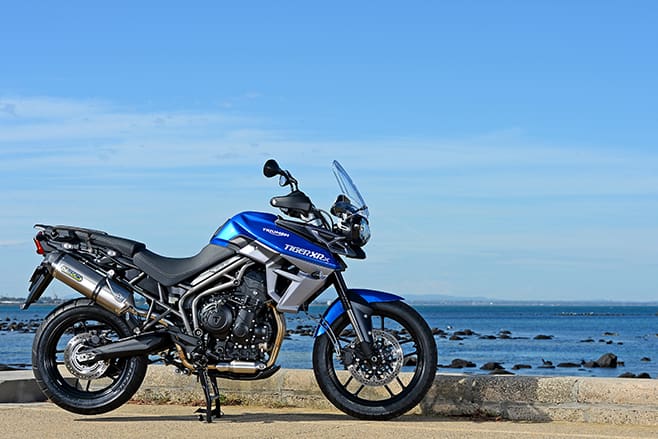
And often these, sometimes very broad, safety margins are carried over to the production bike. The drawback of this is that the generator is one of the most significant factors in engine power output losses, and also contributes to fuel-wasting magnetic and mechanical drag. So, in the long-run it is beneficial to revise the generator to a more appropriate output whenever possible.
One area of the Tiger 800 which has been very restrictive to performance since the first model is the air intake duct. This, finally, has been opened up to allow the little Tiger to breathe. This is more than likely to be another modification which has been possible due to the fly-by-wire throttle operation. Previously the noise emission regulations have required the intake to be restricted to avoid excess noise from a fully open throttle at low revs. Now the throttle valve is manipulated by the ECU the same restriction can be achieved electronically, while enjoying the benefit of more air volume at high rpm.
Problems with stalling the previous Tiger 800 have been rectified with the new RBW throttle bodies, too. The stepper motor on the outgoing model was very basic because it was only required to adjust the position of the valve closed stop. Subsequently it was problematic, and sometimes failed to do its job of keeping the engine from stalling. The advanced stepper control needed for full RBW means the throttle valve reaction times are quicker and adjustments finer.
Triumph Australia, perhaps bravely, chose to include a considerable chunk of dirt road into the return route to Melbourne, and while the Otway Ranges are by no means the back end of the Andes, the gravel forest roads plus a few rough sandy tracks proved the softer Tiger is quite capable of taking a dusty detour when the need arises.
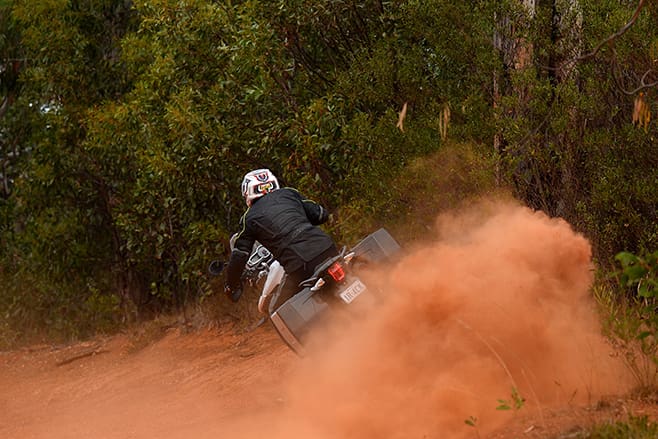
The limiting factor here was more in the shorter suspension travel, as the XRx’s Showa fork and shock provide ample damping control to handle rough roads whether loose or sealed surface, but soon bottoms out at both ends when ridden hard over rough ground. This didn’t stop me from being tempted into getting the Tiger airborne though. And I was surprised how balanced the bike felt for this type of riding, even with panniers fitted.
Back on the tarmac you are reminded of this particular Tiger’s real raison d’être, lightweight touring at a speed which allows you to enjoy the scenery. Cruising speed on ever-changing surfaces is the Tiger’s natural environment. Road scratching to a level that would scare a sportsbike certainly isn’t the Tiger’s forte, and ground clearance while cornering runs out at just the right time to keep your enthusiasm in line with the bike’s intended purpose. The Tiger XR series’ ultra-steep head angle and small trail figure are unusual for this type of bike, though common practice for modern Triumphs.
And while this style of chassis geometry is great for weaving in and out of traffic and low speed manoeuvrability, it can also produce a certain amount of front-end vagueness at extreme lean angles. A softer, more road-biased tyre up front will counter this, but will also compromise performance on gravel roads where the OE fitment Pirelli Scorpion Trail tyres provide a reasonable level of grip and feel.
All in all, the Tiger handles within its brief on the bitumen, and outperformed my expectations on dirt. As with any multipurpose bike, it’s important to choose your tyres in accordance with your expected terrain(s), and anticipate the compromises. And in the end, a 19-inch front wheel is simply a sensible compromise between road and off-road performance.
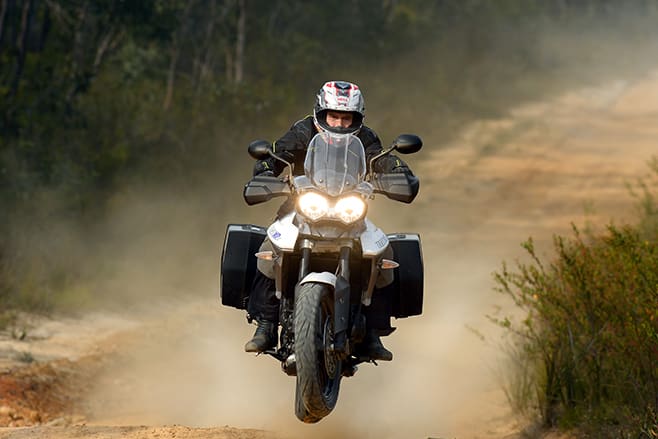
Much of what has been updated on the new Tiger 800 range has stemmed from owner feedback, which is a sensible way to approach evolution. Heat radiation from the engine onto the rider’s legs is one such area of improvement demanded by owners of the previous model. Revised shrouding and cooling of the engine has achieved the dual aims of boosting performance while also improving rider comfort.
The biggest news item on the second generation Tiger 800s is without doubt the addition of Triumph Traction Control (TTC) on all models, and on the up-specced XRx and XCx models you also get the option of three riding modes. Road and Off-Road modes provide default settings for TTC, throttle mapping, and ABS control, with Off-Road mode allowing more wheel slip for TTC and ABS intervention only for the front wheel and at a lesser amount than Road Mode. The third riding mode choice, Rider Mode, is programmable for TTC, ABS, and throttle mapping and also allows TTC and ABS to be completely disabled.
With the introduction of RBW throttle, Triumph has been able to include cruise control on the list of extras included on the XRx. The Triumph system works well at quickly adjusting speed on varying road inclines, which is important for providing a stable cruising speed and protecting your licence from radar attack.
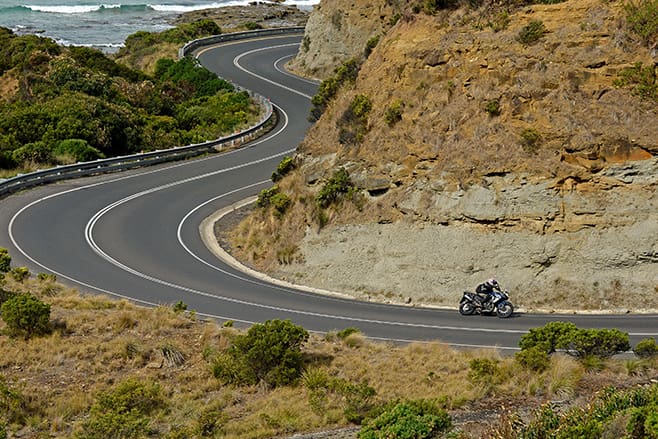
Like the cruise control, all the other goodies offered in the x model are aimed squarely at making the XR into a more complete touring package. Centre stand, hand guards, comfort seats for both rider and pillion, an extra 12v socket and adjustable windscreen. Just add luggage and go.
The Tiger 800 was introduced in 2010, but the Triumph Tiger name goes back to 1938, when 250cc, 350cc and 500cc road models shared the Tiger moniker.

Triumph Tiger 800 XR
Although it is the base model of the range, the XR still as comes standard with traction control, ABS, sump guard, 12v power supply, adjustable seat height, and is fitted with the same chassis, suspension and braking package as the XRx and XRT, and has the same engine performance. Available Now Price $15,090 (+ORC)
Triumph Tiger 800 XRT
The soon to be released XRT has the same spec as the XRx, with the addition of fog lamps, heated seats and grips, uprated 650W alternator, rear rails for the optional aluminium Expedition panniers, GPS mount, tyre pressure monitor, CNC’d brake reservoir, and aluminium radiator guard. Available June 2015 Price $17,890 (+ORC)
This article appears in AMCN Vol 64 No 23